FINC20018 Managerial Finance T3 2019 Assignment 1: Calculation & Essay
VerifiedAdded on 2022/09/06
|10
|2158
|9
Homework Assignment
AI Summary
This document presents a comprehensive solution to a Managerial Finance assignment (FINC20018) from T3 2019. Part A provides detailed calculations addressing various financial scenarios, including compound interest, future value, present value, credit card debt repayment, and financial ratio analysis (ROE, operating profit margin). Part B offers an essay exploring the growing importance of sustainability and social responsibility in finance, discussing socially responsible investing, sustainable finance practices, and their impact on business operations and stakeholder value. The essay examines the integration of environmental, social, and governance (ESG) criteria within financial services and the strategic shift towards long-term sustainable business models. The solution references relevant academic sources to support its arguments and calculations.
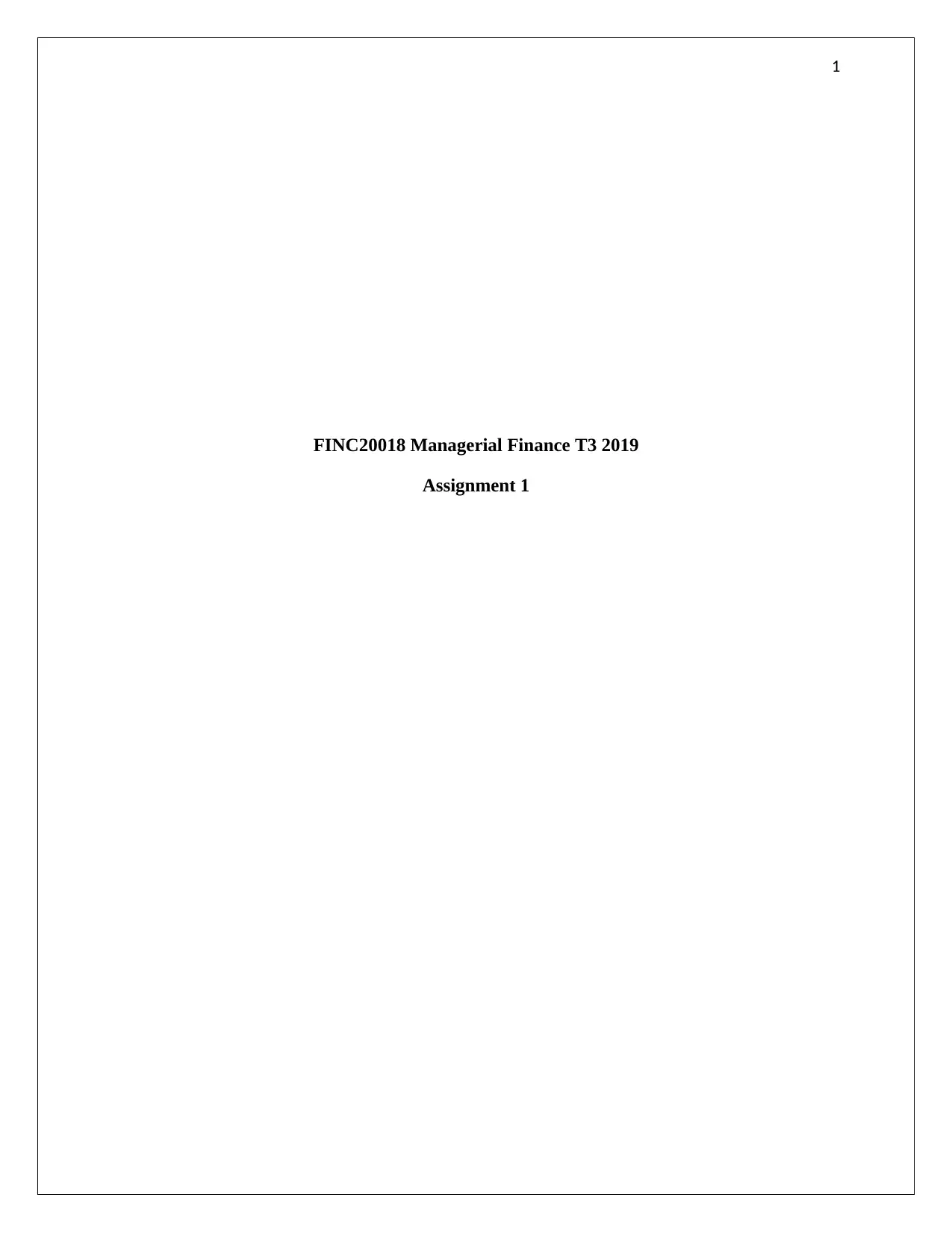
1
FINC20018 Managerial Finance T3 2019
Assignment 1
FINC20018 Managerial Finance T3 2019
Assignment 1
Paraphrase This Document
Need a fresh take? Get an instant paraphrase of this document with our AI Paraphraser
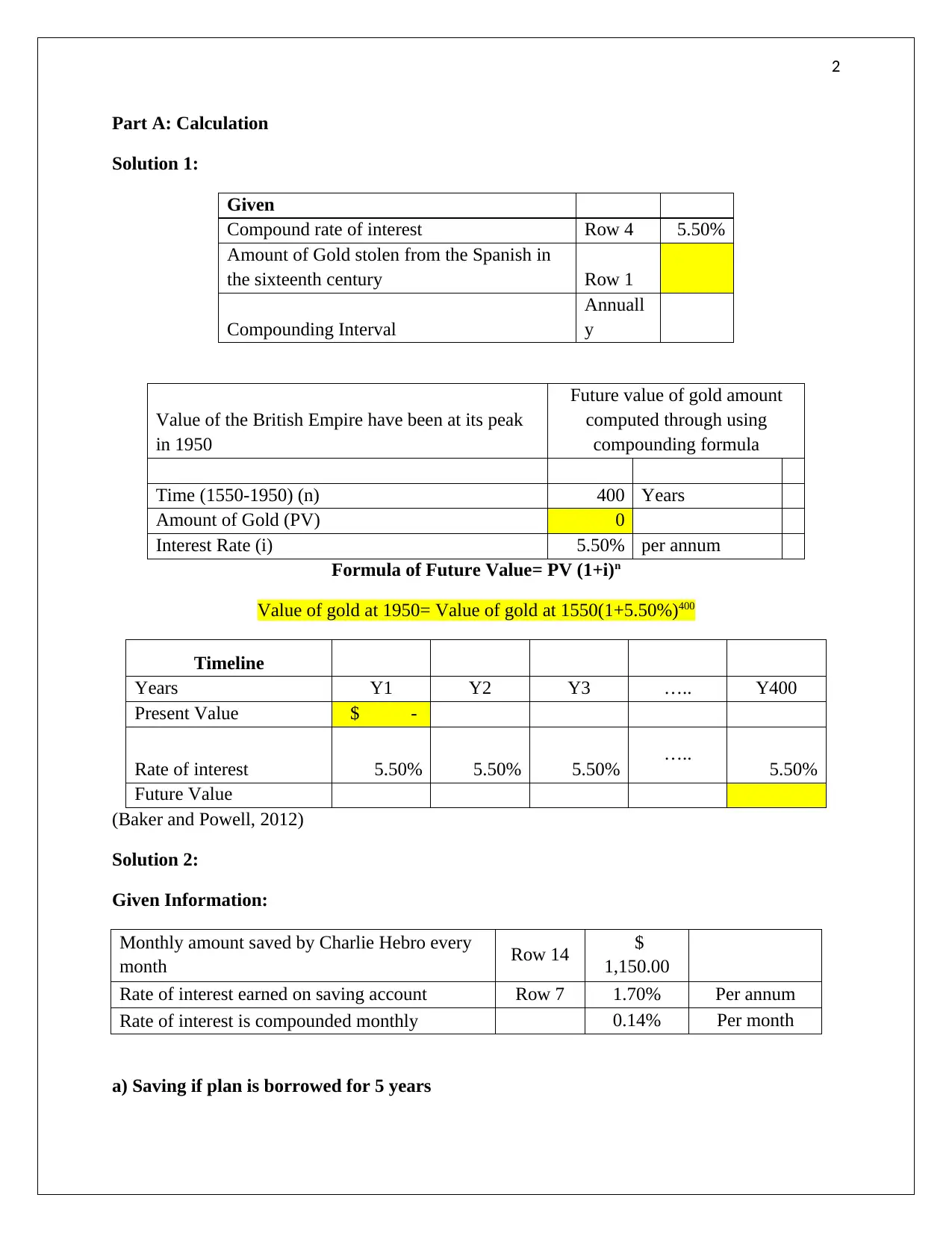
2
Part A: Calculation
Solution 1:
Given
Compound rate of interest Row 4 5.50%
Amount of Gold stolen from the Spanish in
the sixteenth century Row 1
Compounding Interval
Annuall
y
Value of the British Empire have been at its peak
in 1950
Future value of gold amount
computed through using
compounding formula
Time (1550-1950) (n) 400 Years
Amount of Gold (PV) 0
Interest Rate (i) 5.50% per annum
Formula of Future Value= PV (1+i)n
Value of gold at 1950= Value of gold at 1550(1+5.50%)400
Timeline
Years Y1 Y2 Y3 ….. Y400
Present Value $ -
Rate of interest 5.50% 5.50% 5.50% ….. 5.50%
Future Value
(Baker and Powell, 2012)
Solution 2:
Given Information:
Monthly amount saved by Charlie Hebro every
month Row 14 $
1,150.00
Rate of interest earned on saving account Row 7 1.70% Per annum
Rate of interest is compounded monthly 0.14% Per month
a) Saving if plan is borrowed for 5 years
Part A: Calculation
Solution 1:
Given
Compound rate of interest Row 4 5.50%
Amount of Gold stolen from the Spanish in
the sixteenth century Row 1
Compounding Interval
Annuall
y
Value of the British Empire have been at its peak
in 1950
Future value of gold amount
computed through using
compounding formula
Time (1550-1950) (n) 400 Years
Amount of Gold (PV) 0
Interest Rate (i) 5.50% per annum
Formula of Future Value= PV (1+i)n
Value of gold at 1950= Value of gold at 1550(1+5.50%)400
Timeline
Years Y1 Y2 Y3 ….. Y400
Present Value $ -
Rate of interest 5.50% 5.50% 5.50% ….. 5.50%
Future Value
(Baker and Powell, 2012)
Solution 2:
Given Information:
Monthly amount saved by Charlie Hebro every
month Row 14 $
1,150.00
Rate of interest earned on saving account Row 7 1.70% Per annum
Rate of interest is compounded monthly 0.14% Per month
a) Saving if plan is borrowed for 5 years
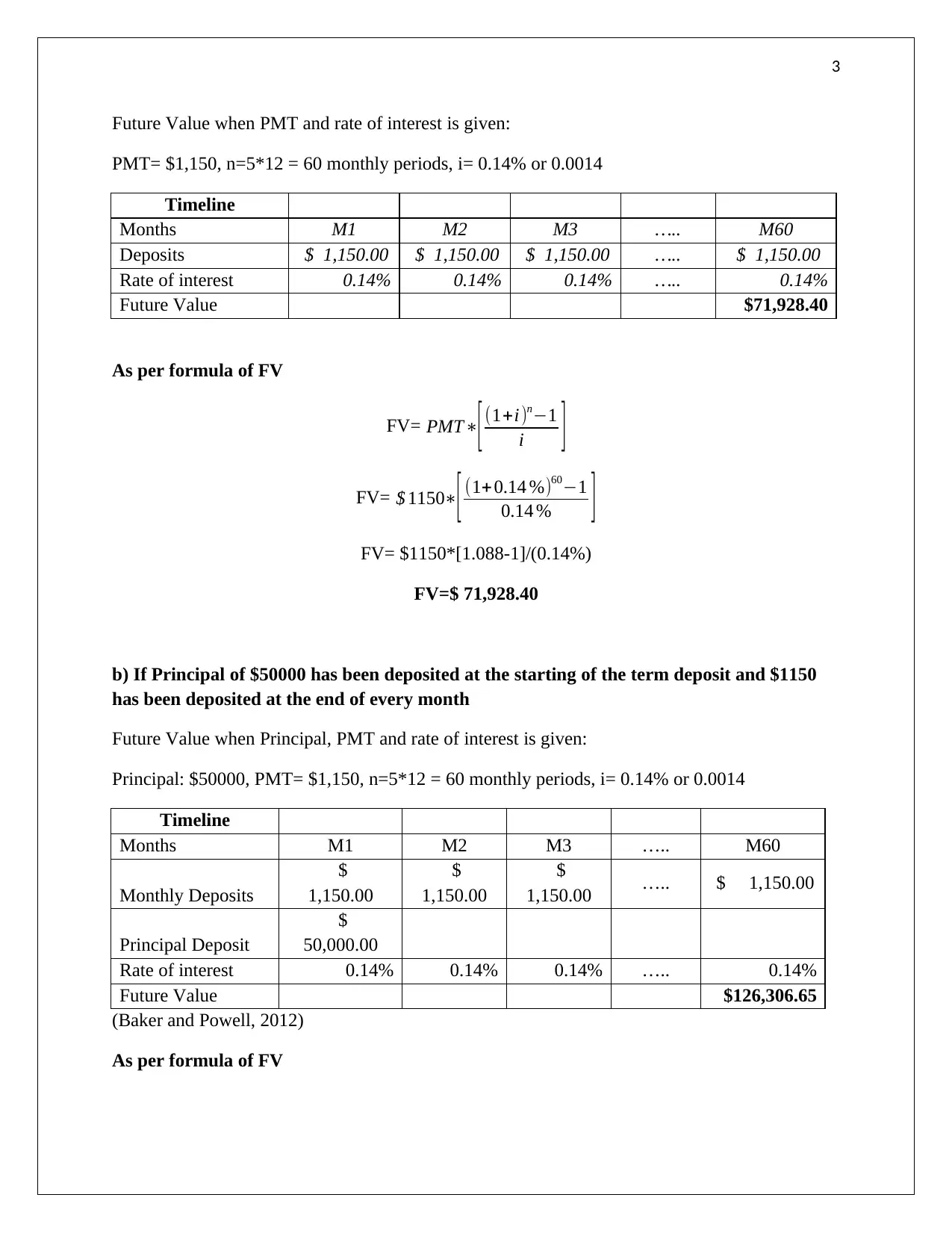
3
Future Value when PMT and rate of interest is given:
PMT= $1,150, n=5*12 = 60 monthly periods, i= 0.14% or 0.0014
Timeline
Months M1 M2 M3 ….. M60
Deposits $ 1,150.00 $ 1,150.00 $ 1,150.00 ….. $ 1,150.00
Rate of interest 0.14% 0.14% 0.14% ….. 0.14%
Future Value $71,928.40
As per formula of FV
FV= PMT∗[(1+i)n−1
i ]
FV= $ 1150∗[ (1+ 0.14 %)60−1
0.14 % ]
FV= $1150*[1.088-1]/(0.14%)
FV=$ 71,928.40
b) If Principal of $50000 has been deposited at the starting of the term deposit and $1150
has been deposited at the end of every month
Future Value when Principal, PMT and rate of interest is given:
Principal: $50000, PMT= $1,150, n=5*12 = 60 monthly periods, i= 0.14% or 0.0014
Timeline
Months M1 M2 M3 ….. M60
Monthly Deposits
$
1,150.00
$
1,150.00
$
1,150.00 ….. $ 1,150.00
Principal Deposit
$
50,000.00
Rate of interest 0.14% 0.14% 0.14% ….. 0.14%
Future Value $126,306.65
(Baker and Powell, 2012)
As per formula of FV
Future Value when PMT and rate of interest is given:
PMT= $1,150, n=5*12 = 60 monthly periods, i= 0.14% or 0.0014
Timeline
Months M1 M2 M3 ….. M60
Deposits $ 1,150.00 $ 1,150.00 $ 1,150.00 ….. $ 1,150.00
Rate of interest 0.14% 0.14% 0.14% ….. 0.14%
Future Value $71,928.40
As per formula of FV
FV= PMT∗[(1+i)n−1
i ]
FV= $ 1150∗[ (1+ 0.14 %)60−1
0.14 % ]
FV= $1150*[1.088-1]/(0.14%)
FV=$ 71,928.40
b) If Principal of $50000 has been deposited at the starting of the term deposit and $1150
has been deposited at the end of every month
Future Value when Principal, PMT and rate of interest is given:
Principal: $50000, PMT= $1,150, n=5*12 = 60 monthly periods, i= 0.14% or 0.0014
Timeline
Months M1 M2 M3 ….. M60
Monthly Deposits
$
1,150.00
$
1,150.00
$
1,150.00 ….. $ 1,150.00
Principal Deposit
$
50,000.00
Rate of interest 0.14% 0.14% 0.14% ….. 0.14%
Future Value $126,306.65
(Baker and Powell, 2012)
As per formula of FV
⊘ This is a preview!⊘
Do you want full access?
Subscribe today to unlock all pages.

Trusted by 1+ million students worldwide
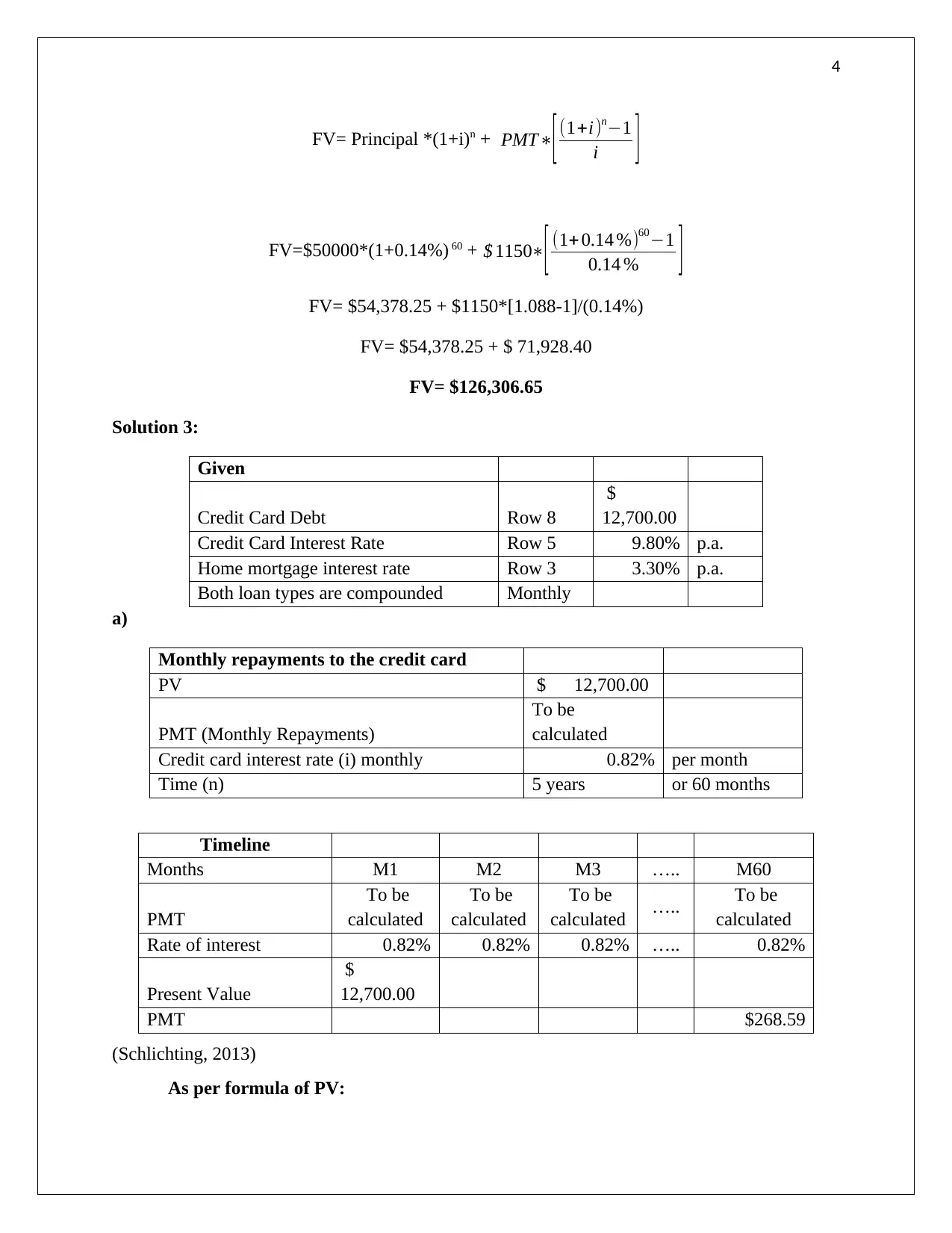
4
FV= Principal *(1+i)n + PMT∗[ (1+i)n−1
i ]
FV=$50000*(1+0.14%) 60 + $ 1150∗[ (1+0.14 %)60−1
0.14 % ]
FV= $54,378.25 + $1150*[1.088-1]/(0.14%)
FV= $54,378.25 + $ 71,928.40
FV= $126,306.65
Solution 3:
Given
Credit Card Debt Row 8
$
12,700.00
Credit Card Interest Rate Row 5 9.80% p.a.
Home mortgage interest rate Row 3 3.30% p.a.
Both loan types are compounded Monthly
a)
Monthly repayments to the credit card
PV $ 12,700.00
PMT (Monthly Repayments)
To be
calculated
Credit card interest rate (i) monthly 0.82% per month
Time (n) 5 years or 60 months
Timeline
Months M1 M2 M3 ….. M60
PMT
To be
calculated
To be
calculated
To be
calculated ….. To be
calculated
Rate of interest 0.82% 0.82% 0.82% ….. 0.82%
Present Value
$
12,700.00
PMT $268.59
(Schlichting, 2013)
As per formula of PV:
FV= Principal *(1+i)n + PMT∗[ (1+i)n−1
i ]
FV=$50000*(1+0.14%) 60 + $ 1150∗[ (1+0.14 %)60−1
0.14 % ]
FV= $54,378.25 + $1150*[1.088-1]/(0.14%)
FV= $54,378.25 + $ 71,928.40
FV= $126,306.65
Solution 3:
Given
Credit Card Debt Row 8
$
12,700.00
Credit Card Interest Rate Row 5 9.80% p.a.
Home mortgage interest rate Row 3 3.30% p.a.
Both loan types are compounded Monthly
a)
Monthly repayments to the credit card
PV $ 12,700.00
PMT (Monthly Repayments)
To be
calculated
Credit card interest rate (i) monthly 0.82% per month
Time (n) 5 years or 60 months
Timeline
Months M1 M2 M3 ….. M60
PMT
To be
calculated
To be
calculated
To be
calculated ….. To be
calculated
Rate of interest 0.82% 0.82% 0.82% ….. 0.82%
Present Value
$
12,700.00
PMT $268.59
(Schlichting, 2013)
As per formula of PV:
Paraphrase This Document
Need a fresh take? Get an instant paraphrase of this document with our AI Paraphraser
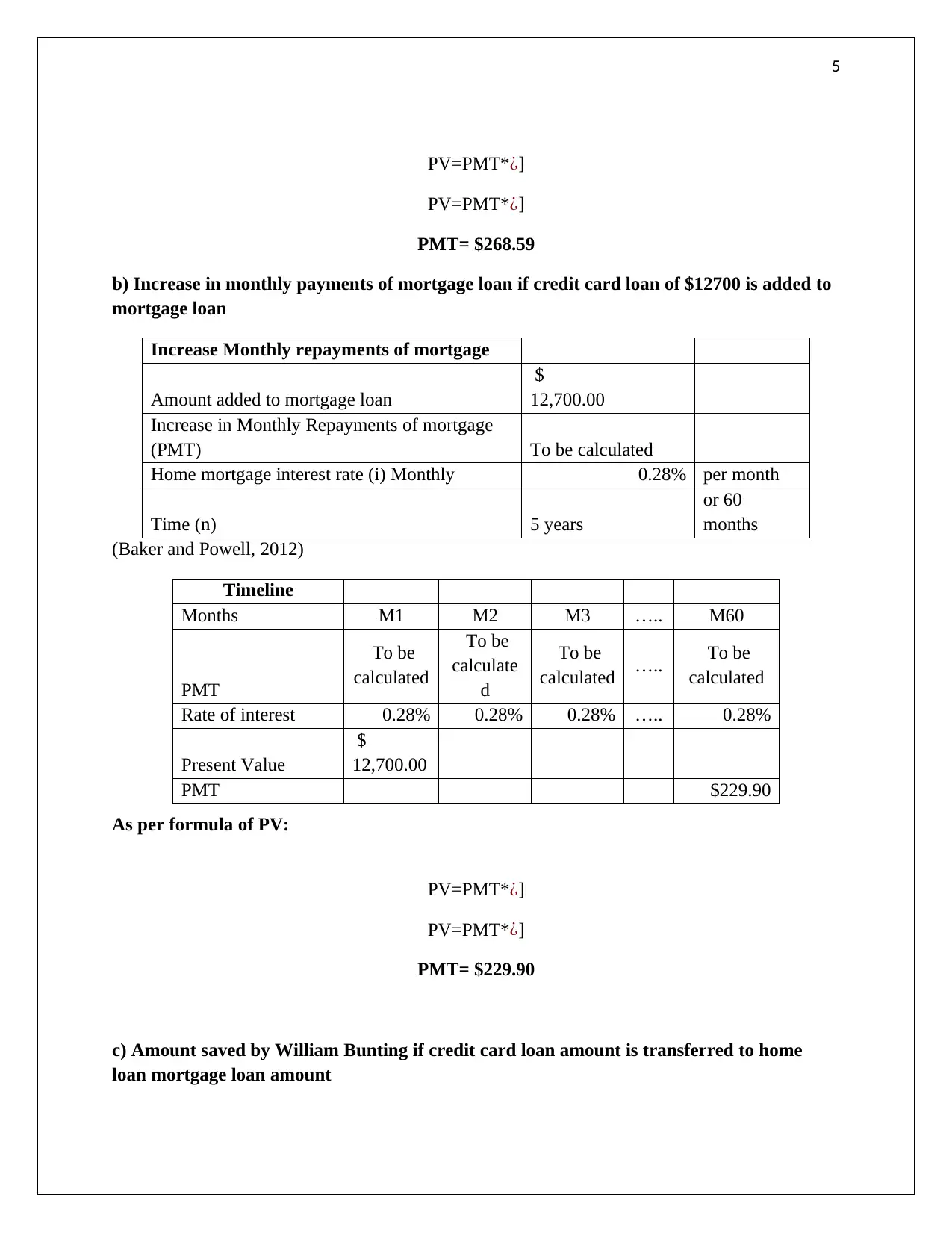
5
PV=PMT*¿]
PV=PMT*¿]
PMT= $268.59
b) Increase in monthly payments of mortgage loan if credit card loan of $12700 is added to
mortgage loan
Increase Monthly repayments of mortgage
Amount added to mortgage loan
$
12,700.00
Increase in Monthly Repayments of mortgage
(PMT) To be calculated
Home mortgage interest rate (i) Monthly 0.28% per month
Time (n) 5 years
or 60
months
(Baker and Powell, 2012)
Timeline
Months M1 M2 M3 ….. M60
PMT
To be
calculated
To be
calculate
d
To be
calculated ….. To be
calculated
Rate of interest 0.28% 0.28% 0.28% ….. 0.28%
Present Value
$
12,700.00
PMT $229.90
As per formula of PV:
PV=PMT*¿]
PV=PMT*¿]
PMT= $229.90
c) Amount saved by William Bunting if credit card loan amount is transferred to home
loan mortgage loan amount
PV=PMT*¿]
PV=PMT*¿]
PMT= $268.59
b) Increase in monthly payments of mortgage loan if credit card loan of $12700 is added to
mortgage loan
Increase Monthly repayments of mortgage
Amount added to mortgage loan
$
12,700.00
Increase in Monthly Repayments of mortgage
(PMT) To be calculated
Home mortgage interest rate (i) Monthly 0.28% per month
Time (n) 5 years
or 60
months
(Baker and Powell, 2012)
Timeline
Months M1 M2 M3 ….. M60
PMT
To be
calculated
To be
calculate
d
To be
calculated ….. To be
calculated
Rate of interest 0.28% 0.28% 0.28% ….. 0.28%
Present Value
$
12,700.00
PMT $229.90
As per formula of PV:
PV=PMT*¿]
PV=PMT*¿]
PMT= $229.90
c) Amount saved by William Bunting if credit card loan amount is transferred to home
loan mortgage loan amount
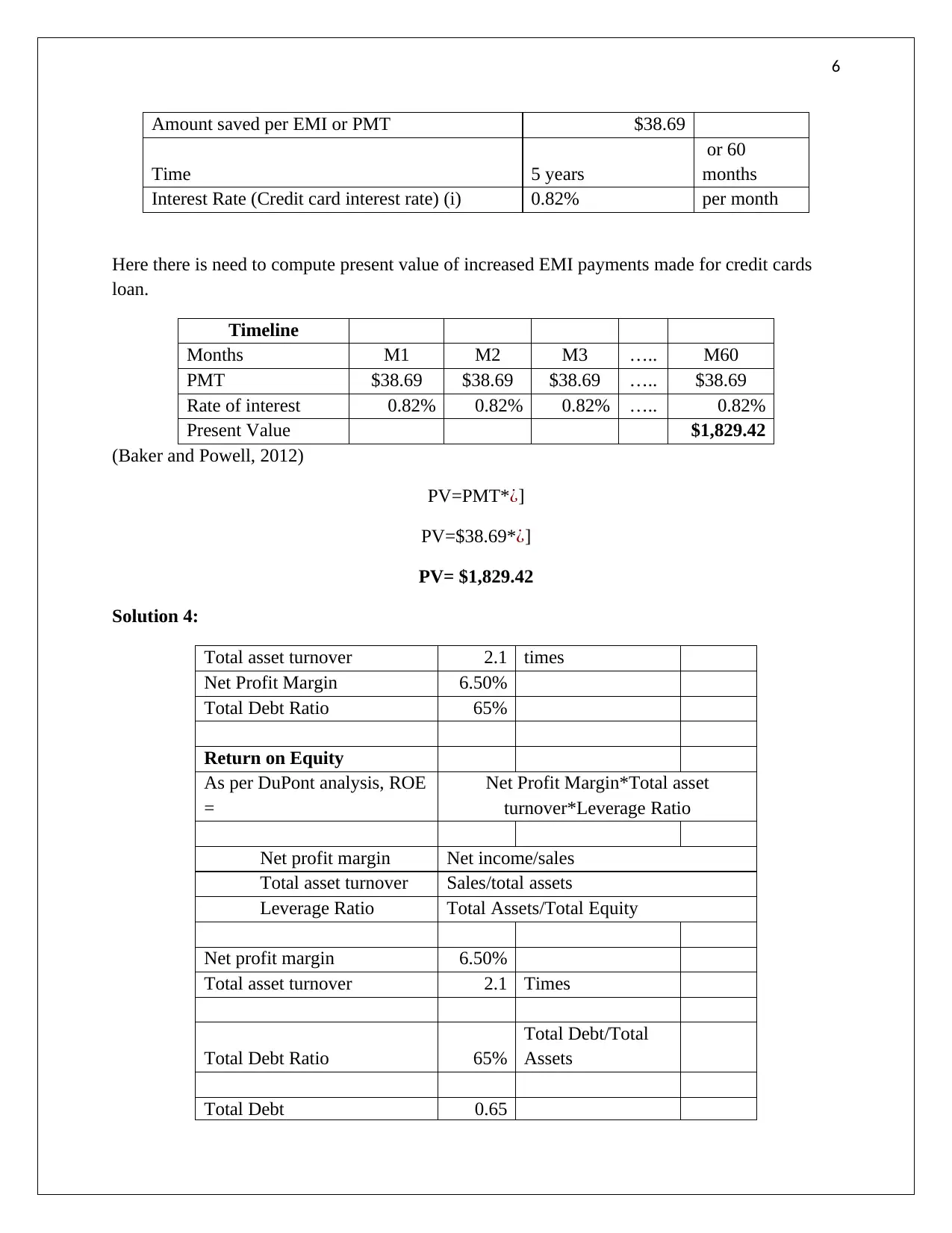
6
Amount saved per EMI or PMT $38.69
Time 5 years
or 60
months
Interest Rate (Credit card interest rate) (i) 0.82% per month
Here there is need to compute present value of increased EMI payments made for credit cards
loan.
Timeline
Months M1 M2 M3 ….. M60
PMT $38.69 $38.69 $38.69 ….. $38.69
Rate of interest 0.82% 0.82% 0.82% ….. 0.82%
Present Value $1,829.42
(Baker and Powell, 2012)
PV=PMT*¿]
PV=$38.69*¿]
PV= $1,829.42
Solution 4:
Total asset turnover 2.1 times
Net Profit Margin 6.50%
Total Debt Ratio 65%
Return on Equity
As per DuPont analysis, ROE
=
Net Profit Margin*Total asset
turnover*Leverage Ratio
Net profit margin Net income/sales
Total asset turnover Sales/total assets
Leverage Ratio Total Assets/Total Equity
Net profit margin 6.50%
Total asset turnover 2.1 Times
Total Debt Ratio 65%
Total Debt/Total
Assets
Total Debt 0.65
Amount saved per EMI or PMT $38.69
Time 5 years
or 60
months
Interest Rate (Credit card interest rate) (i) 0.82% per month
Here there is need to compute present value of increased EMI payments made for credit cards
loan.
Timeline
Months M1 M2 M3 ….. M60
PMT $38.69 $38.69 $38.69 ….. $38.69
Rate of interest 0.82% 0.82% 0.82% ….. 0.82%
Present Value $1,829.42
(Baker and Powell, 2012)
PV=PMT*¿]
PV=$38.69*¿]
PV= $1,829.42
Solution 4:
Total asset turnover 2.1 times
Net Profit Margin 6.50%
Total Debt Ratio 65%
Return on Equity
As per DuPont analysis, ROE
=
Net Profit Margin*Total asset
turnover*Leverage Ratio
Net profit margin Net income/sales
Total asset turnover Sales/total assets
Leverage Ratio Total Assets/Total Equity
Net profit margin 6.50%
Total asset turnover 2.1 Times
Total Debt Ratio 65%
Total Debt/Total
Assets
Total Debt 0.65
⊘ This is a preview!⊘
Do you want full access?
Subscribe today to unlock all pages.

Trusted by 1+ million students worldwide
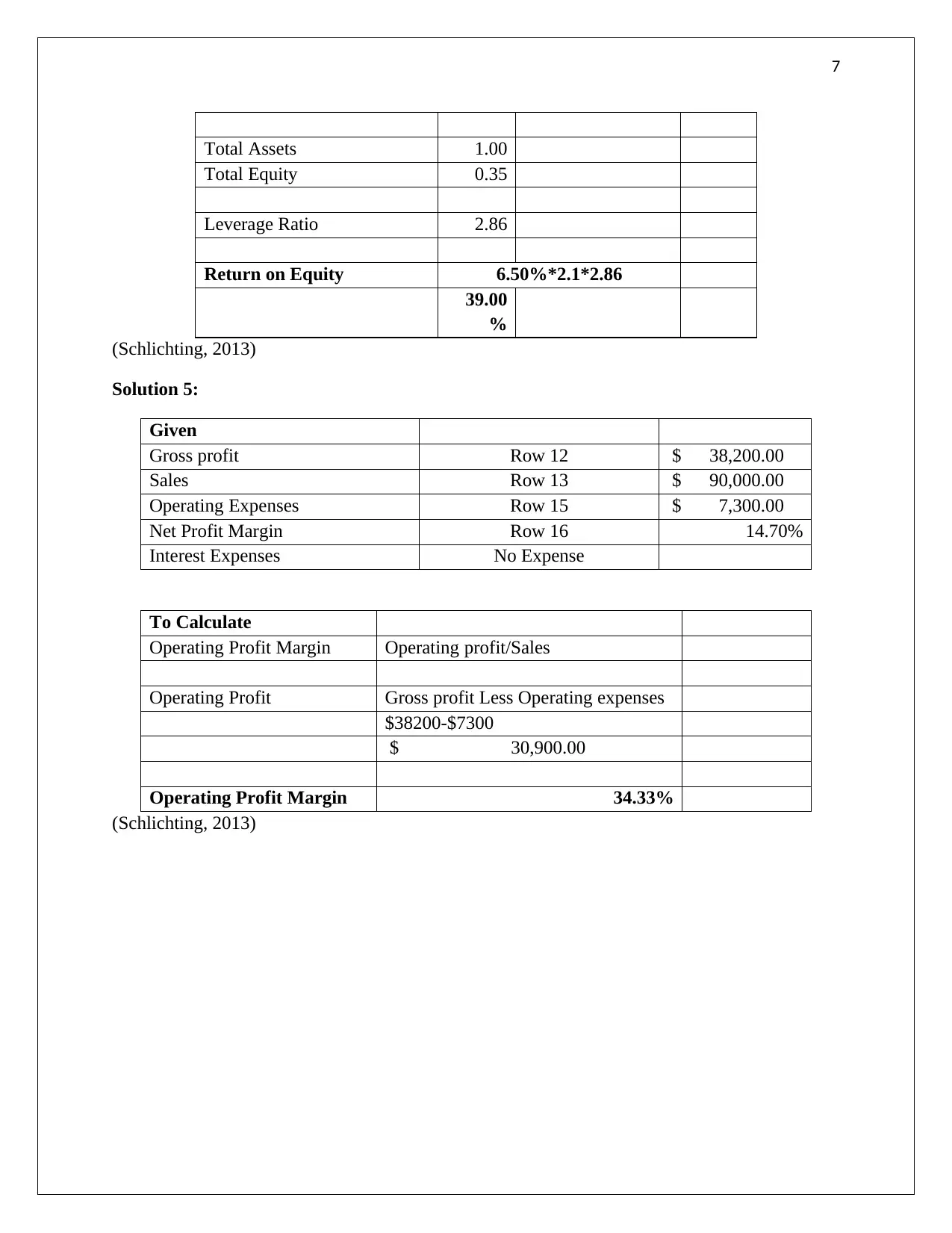
7
Total Assets 1.00
Total Equity 0.35
Leverage Ratio 2.86
Return on Equity 6.50%*2.1*2.86
39.00
%
(Schlichting, 2013)
Solution 5:
Given
Gross profit Row 12 $ 38,200.00
Sales Row 13 $ 90,000.00
Operating Expenses Row 15 $ 7,300.00
Net Profit Margin Row 16 14.70%
Interest Expenses No Expense
To Calculate
Operating Profit Margin Operating profit/Sales
Operating Profit Gross profit Less Operating expenses
$38200-$7300
$ 30,900.00
Operating Profit Margin 34.33%
(Schlichting, 2013)
Total Assets 1.00
Total Equity 0.35
Leverage Ratio 2.86
Return on Equity 6.50%*2.1*2.86
39.00
%
(Schlichting, 2013)
Solution 5:
Given
Gross profit Row 12 $ 38,200.00
Sales Row 13 $ 90,000.00
Operating Expenses Row 15 $ 7,300.00
Net Profit Margin Row 16 14.70%
Interest Expenses No Expense
To Calculate
Operating Profit Margin Operating profit/Sales
Operating Profit Gross profit Less Operating expenses
$38200-$7300
$ 30,900.00
Operating Profit Margin 34.33%
(Schlichting, 2013)
Paraphrase This Document
Need a fresh take? Get an instant paraphrase of this document with our AI Paraphraser
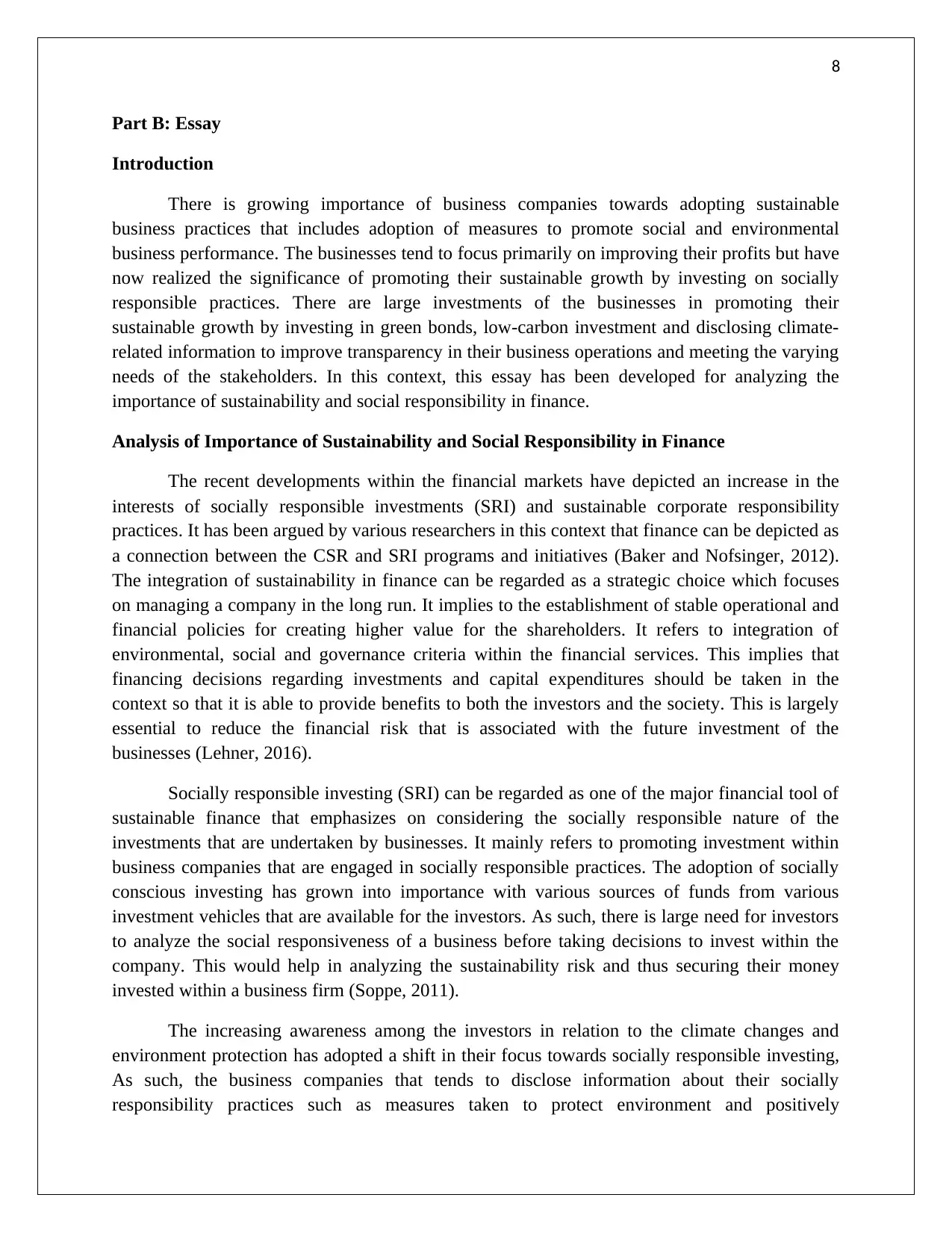
8
Part B: Essay
Introduction
There is growing importance of business companies towards adopting sustainable
business practices that includes adoption of measures to promote social and environmental
business performance. The businesses tend to focus primarily on improving their profits but have
now realized the significance of promoting their sustainable growth by investing on socially
responsible practices. There are large investments of the businesses in promoting their
sustainable growth by investing in green bonds, low-carbon investment and disclosing climate-
related information to improve transparency in their business operations and meeting the varying
needs of the stakeholders. In this context, this essay has been developed for analyzing the
importance of sustainability and social responsibility in finance.
Analysis of Importance of Sustainability and Social Responsibility in Finance
The recent developments within the financial markets have depicted an increase in the
interests of socially responsible investments (SRI) and sustainable corporate responsibility
practices. It has been argued by various researchers in this context that finance can be depicted as
a connection between the CSR and SRI programs and initiatives (Baker and Nofsinger, 2012).
The integration of sustainability in finance can be regarded as a strategic choice which focuses
on managing a company in the long run. It implies to the establishment of stable operational and
financial policies for creating higher value for the shareholders. It refers to integration of
environmental, social and governance criteria within the financial services. This implies that
financing decisions regarding investments and capital expenditures should be taken in the
context so that it is able to provide benefits to both the investors and the society. This is largely
essential to reduce the financial risk that is associated with the future investment of the
businesses (Lehner, 2016).
Socially responsible investing (SRI) can be regarded as one of the major financial tool of
sustainable finance that emphasizes on considering the socially responsible nature of the
investments that are undertaken by businesses. It mainly refers to promoting investment within
business companies that are engaged in socially responsible practices. The adoption of socially
conscious investing has grown into importance with various sources of funds from various
investment vehicles that are available for the investors. As such, there is large need for investors
to analyze the social responsiveness of a business before taking decisions to invest within the
company. This would help in analyzing the sustainability risk and thus securing their money
invested within a business firm (Soppe, 2011).
The increasing awareness among the investors in relation to the climate changes and
environment protection has adopted a shift in their focus towards socially responsible investing,
As such, the business companies that tends to disclose information about their socially
responsibility practices such as measures taken to protect environment and positively
Part B: Essay
Introduction
There is growing importance of business companies towards adopting sustainable
business practices that includes adoption of measures to promote social and environmental
business performance. The businesses tend to focus primarily on improving their profits but have
now realized the significance of promoting their sustainable growth by investing on socially
responsible practices. There are large investments of the businesses in promoting their
sustainable growth by investing in green bonds, low-carbon investment and disclosing climate-
related information to improve transparency in their business operations and meeting the varying
needs of the stakeholders. In this context, this essay has been developed for analyzing the
importance of sustainability and social responsibility in finance.
Analysis of Importance of Sustainability and Social Responsibility in Finance
The recent developments within the financial markets have depicted an increase in the
interests of socially responsible investments (SRI) and sustainable corporate responsibility
practices. It has been argued by various researchers in this context that finance can be depicted as
a connection between the CSR and SRI programs and initiatives (Baker and Nofsinger, 2012).
The integration of sustainability in finance can be regarded as a strategic choice which focuses
on managing a company in the long run. It implies to the establishment of stable operational and
financial policies for creating higher value for the shareholders. It refers to integration of
environmental, social and governance criteria within the financial services. This implies that
financing decisions regarding investments and capital expenditures should be taken in the
context so that it is able to provide benefits to both the investors and the society. This is largely
essential to reduce the financial risk that is associated with the future investment of the
businesses (Lehner, 2016).
Socially responsible investing (SRI) can be regarded as one of the major financial tool of
sustainable finance that emphasizes on considering the socially responsible nature of the
investments that are undertaken by businesses. It mainly refers to promoting investment within
business companies that are engaged in socially responsible practices. The adoption of socially
conscious investing has grown into importance with various sources of funds from various
investment vehicles that are available for the investors. As such, there is large need for investors
to analyze the social responsiveness of a business before taking decisions to invest within the
company. This would help in analyzing the sustainability risk and thus securing their money
invested within a business firm (Soppe, 2011).
The increasing awareness among the investors in relation to the climate changes and
environment protection has adopted a shift in their focus towards socially responsible investing,
As such, the business companies that tends to disclose information about their socially
responsibility practices such as measures taken to protect environment and positively
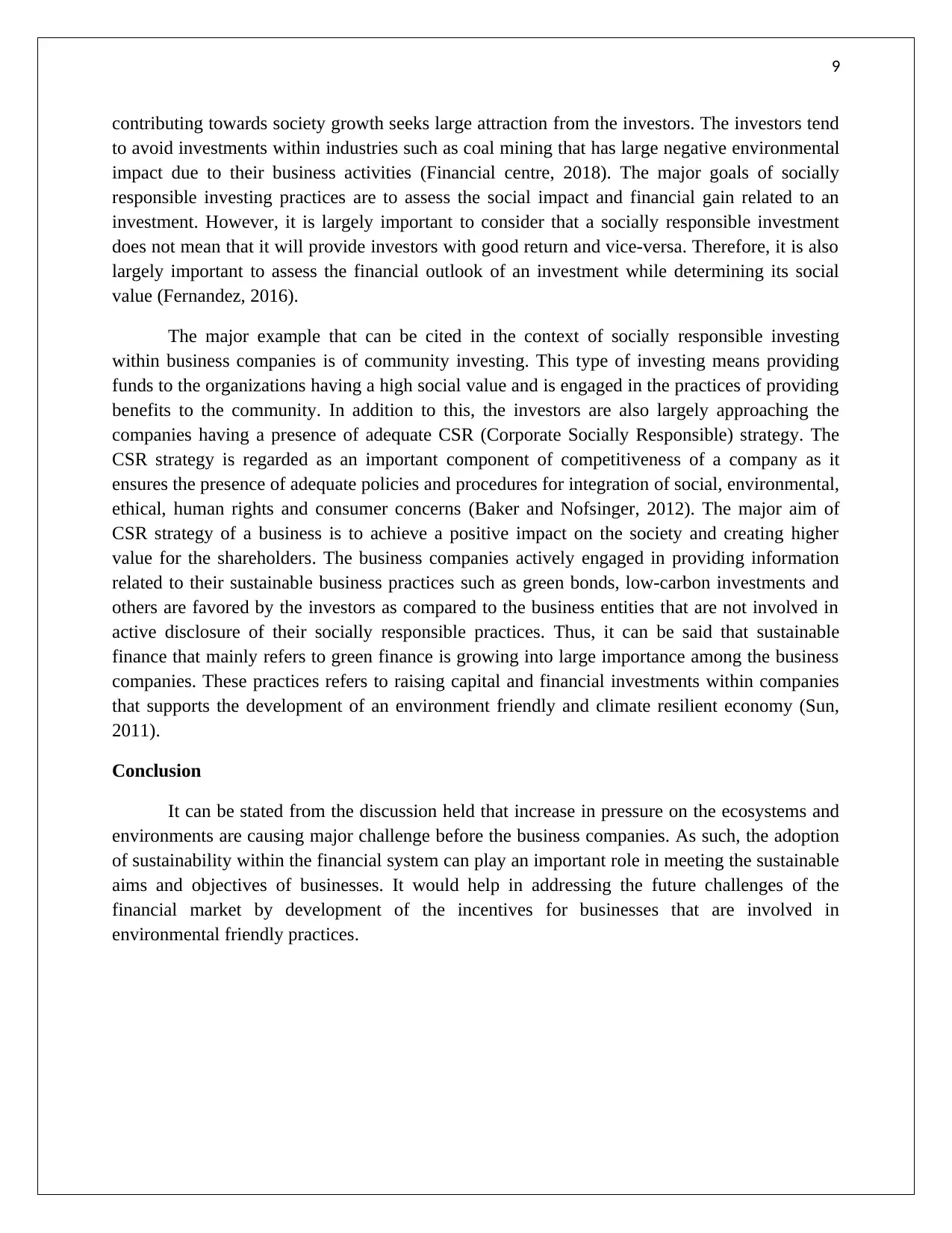
9
contributing towards society growth seeks large attraction from the investors. The investors tend
to avoid investments within industries such as coal mining that has large negative environmental
impact due to their business activities (Financial centre, 2018). The major goals of socially
responsible investing practices are to assess the social impact and financial gain related to an
investment. However, it is largely important to consider that a socially responsible investment
does not mean that it will provide investors with good return and vice-versa. Therefore, it is also
largely important to assess the financial outlook of an investment while determining its social
value (Fernandez, 2016).
The major example that can be cited in the context of socially responsible investing
within business companies is of community investing. This type of investing means providing
funds to the organizations having a high social value and is engaged in the practices of providing
benefits to the community. In addition to this, the investors are also largely approaching the
companies having a presence of adequate CSR (Corporate Socially Responsible) strategy. The
CSR strategy is regarded as an important component of competitiveness of a company as it
ensures the presence of adequate policies and procedures for integration of social, environmental,
ethical, human rights and consumer concerns (Baker and Nofsinger, 2012). The major aim of
CSR strategy of a business is to achieve a positive impact on the society and creating higher
value for the shareholders. The business companies actively engaged in providing information
related to their sustainable business practices such as green bonds, low-carbon investments and
others are favored by the investors as compared to the business entities that are not involved in
active disclosure of their socially responsible practices. Thus, it can be said that sustainable
finance that mainly refers to green finance is growing into large importance among the business
companies. These practices refers to raising capital and financial investments within companies
that supports the development of an environment friendly and climate resilient economy (Sun,
2011).
Conclusion
It can be stated from the discussion held that increase in pressure on the ecosystems and
environments are causing major challenge before the business companies. As such, the adoption
of sustainability within the financial system can play an important role in meeting the sustainable
aims and objectives of businesses. It would help in addressing the future challenges of the
financial market by development of the incentives for businesses that are involved in
environmental friendly practices.
contributing towards society growth seeks large attraction from the investors. The investors tend
to avoid investments within industries such as coal mining that has large negative environmental
impact due to their business activities (Financial centre, 2018). The major goals of socially
responsible investing practices are to assess the social impact and financial gain related to an
investment. However, it is largely important to consider that a socially responsible investment
does not mean that it will provide investors with good return and vice-versa. Therefore, it is also
largely important to assess the financial outlook of an investment while determining its social
value (Fernandez, 2016).
The major example that can be cited in the context of socially responsible investing
within business companies is of community investing. This type of investing means providing
funds to the organizations having a high social value and is engaged in the practices of providing
benefits to the community. In addition to this, the investors are also largely approaching the
companies having a presence of adequate CSR (Corporate Socially Responsible) strategy. The
CSR strategy is regarded as an important component of competitiveness of a company as it
ensures the presence of adequate policies and procedures for integration of social, environmental,
ethical, human rights and consumer concerns (Baker and Nofsinger, 2012). The major aim of
CSR strategy of a business is to achieve a positive impact on the society and creating higher
value for the shareholders. The business companies actively engaged in providing information
related to their sustainable business practices such as green bonds, low-carbon investments and
others are favored by the investors as compared to the business entities that are not involved in
active disclosure of their socially responsible practices. Thus, it can be said that sustainable
finance that mainly refers to green finance is growing into large importance among the business
companies. These practices refers to raising capital and financial investments within companies
that supports the development of an environment friendly and climate resilient economy (Sun,
2011).
Conclusion
It can be stated from the discussion held that increase in pressure on the ecosystems and
environments are causing major challenge before the business companies. As such, the adoption
of sustainability within the financial system can play an important role in meeting the sustainable
aims and objectives of businesses. It would help in addressing the future challenges of the
financial market by development of the incentives for businesses that are involved in
environmental friendly practices.
⊘ This is a preview!⊘
Do you want full access?
Subscribe today to unlock all pages.

Trusted by 1+ million students worldwide
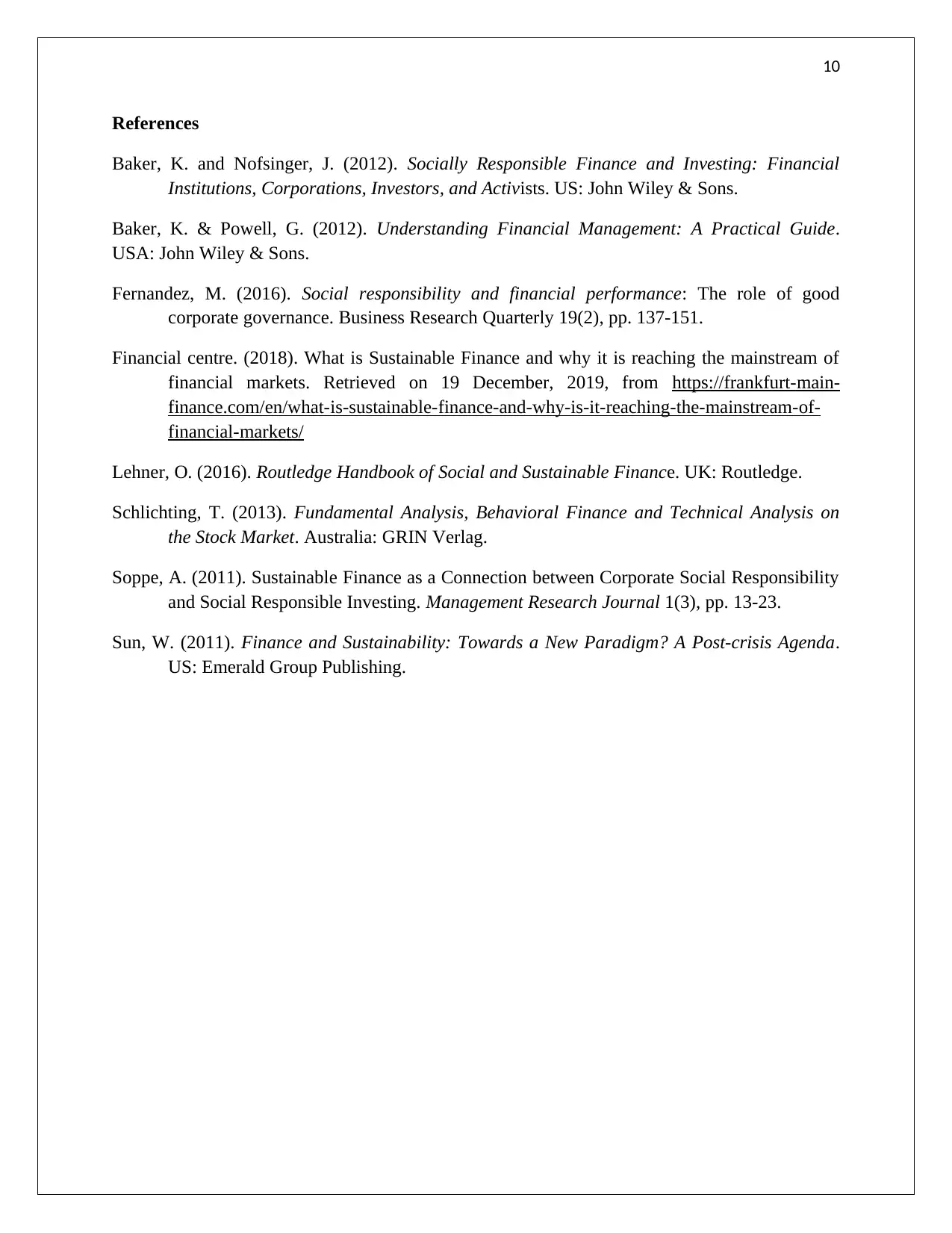
10
References
Baker, K. and Nofsinger, J. (2012). Socially Responsible Finance and Investing: Financial
Institutions, Corporations, Investors, and Activists. US: John Wiley & Sons.
Baker, K. & Powell, G. (2012). Understanding Financial Management: A Practical Guide.
USA: John Wiley & Sons.
Fernandez, M. (2016). Social responsibility and financial performance: The role of good
corporate governance. Business Research Quarterly 19(2), pp. 137-151.
Financial centre. (2018). What is Sustainable Finance and why it is reaching the mainstream of
financial markets. Retrieved on 19 December, 2019, from https://frankfurt-main-
finance.com/en/what-is-sustainable-finance-and-why-is-it-reaching-the-mainstream-of-
financial-markets/
Lehner, O. (2016). Routledge Handbook of Social and Sustainable Finance. UK: Routledge.
Schlichting, T. (2013). Fundamental Analysis, Behavioral Finance and Technical Analysis on
the Stock Market. Australia: GRIN Verlag.
Soppe, A. (2011). Sustainable Finance as a Connection between Corporate Social Responsibility
and Social Responsible Investing. Management Research Journal 1(3), pp. 13-23.
Sun, W. (2011). Finance and Sustainability: Towards a New Paradigm? A Post-crisis Agenda.
US: Emerald Group Publishing.
References
Baker, K. and Nofsinger, J. (2012). Socially Responsible Finance and Investing: Financial
Institutions, Corporations, Investors, and Activists. US: John Wiley & Sons.
Baker, K. & Powell, G. (2012). Understanding Financial Management: A Practical Guide.
USA: John Wiley & Sons.
Fernandez, M. (2016). Social responsibility and financial performance: The role of good
corporate governance. Business Research Quarterly 19(2), pp. 137-151.
Financial centre. (2018). What is Sustainable Finance and why it is reaching the mainstream of
financial markets. Retrieved on 19 December, 2019, from https://frankfurt-main-
finance.com/en/what-is-sustainable-finance-and-why-is-it-reaching-the-mainstream-of-
financial-markets/
Lehner, O. (2016). Routledge Handbook of Social and Sustainable Finance. UK: Routledge.
Schlichting, T. (2013). Fundamental Analysis, Behavioral Finance and Technical Analysis on
the Stock Market. Australia: GRIN Verlag.
Soppe, A. (2011). Sustainable Finance as a Connection between Corporate Social Responsibility
and Social Responsible Investing. Management Research Journal 1(3), pp. 13-23.
Sun, W. (2011). Finance and Sustainability: Towards a New Paradigm? A Post-crisis Agenda.
US: Emerald Group Publishing.
1 out of 10
Related Documents
Your All-in-One AI-Powered Toolkit for Academic Success.
+13062052269
info@desklib.com
Available 24*7 on WhatsApp / Email
![[object Object]](/_next/static/media/star-bottom.7253800d.svg)
Unlock your academic potential
Copyright © 2020–2025 A2Z Services. All Rights Reserved. Developed and managed by ZUCOL.




